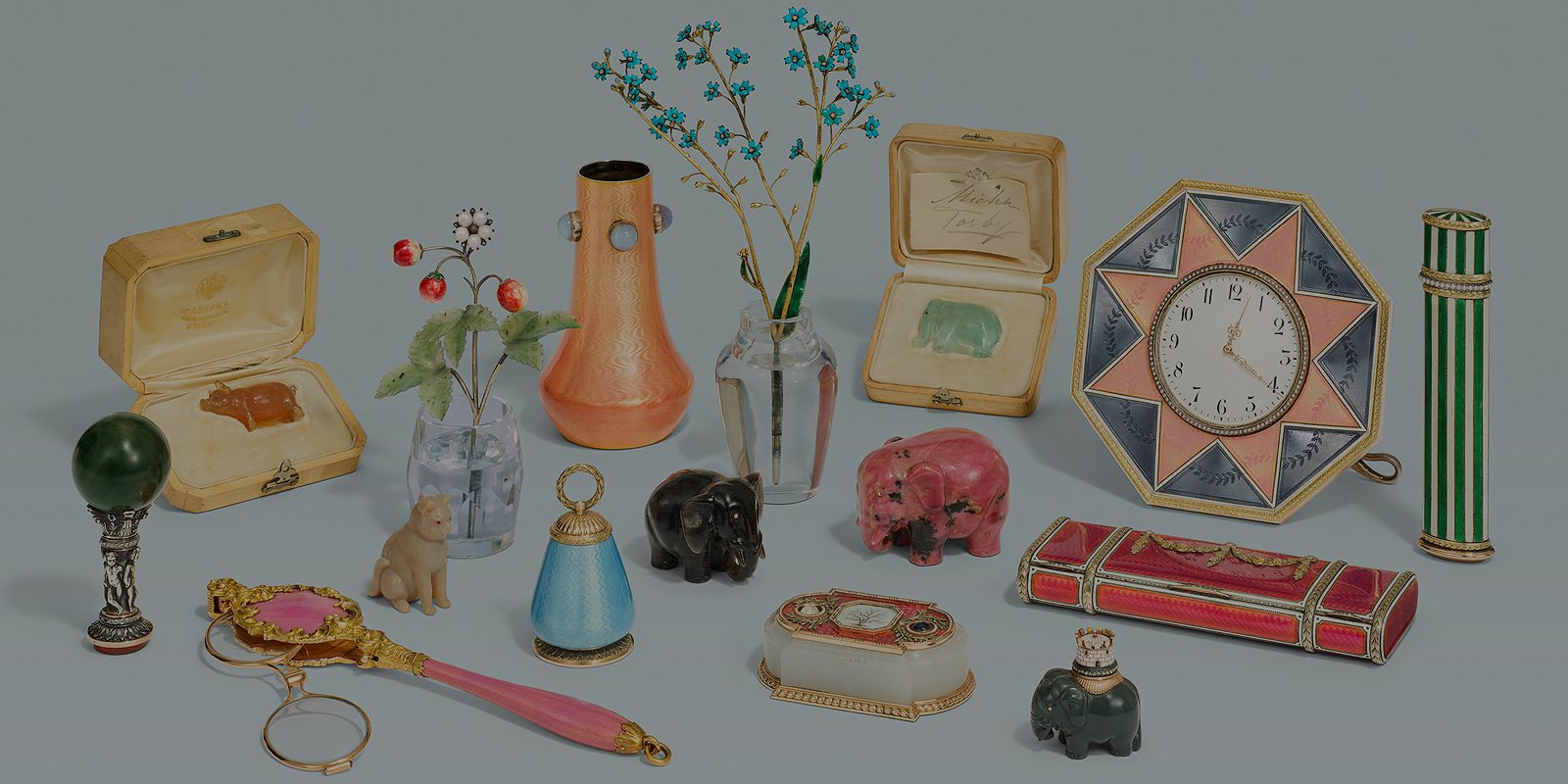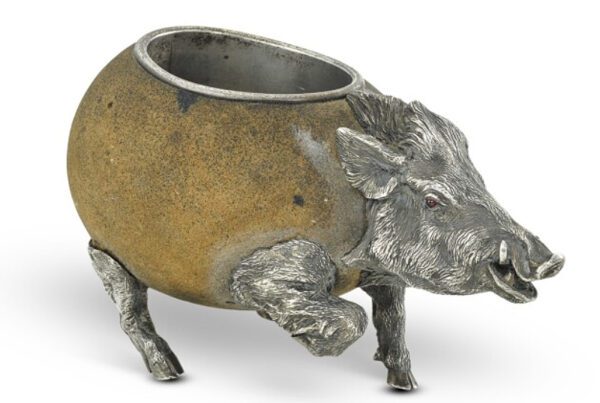I was looking forward to bidding on items from a venerable Fabergé collection in early April – but couldn’t.
The 42-lot ensemble was touted as a major component of Christie’s on-line Collections sale running March 26–April 9. The items were once owned by Grand Duke Mikhail Mikhailovich of Russia (1861-1929), grandson of Tsar Nikolai I. Some were gifts from Tsar Nikolai II and his mother, Dowager Empress Maria Feodorovna. When the Grand Duke died in 1929 the ensemble was inherited by his German-born daughter Lady Zia de Torby (1892-1977), who descended on her mother’s side from Alexander Pushkin and was married to Harold Wernher, son of the late art-collecting diamond-magnate Sir Julius Wernher. The couple lived at Luton Hoo, a stately home just south of Luton, where Prince Philip and the future Queen Elizabeth would spend the first night of their honeymoon in 1947 (Philip’s aunt Nadejda was Lady Zia’s sister).
The house and art collection were open to the public until 1991 (Luton Hoo is now a luxury hotel). Fabergé items – valued in the press at a total £500,000 – were stolen from the house in May 1994 and never recovered, although one gang-member was later nabbed (and jailed for three years in 2001). Police believed the swag had been whisked out of the country straight after the robbery.
Some furniture, works of art and Old Master paintings from the Wernher Collection were sold at Christies’ for over £20m in July 2000. Other parts of the collection – including Fabergé items – went on show at the Ranger’s House in Greenwich until, following the death of Lady Zia’s last surviving child Myra in 2022, it was decided to send them to Christie’s. (Myra had attended the reburial of the last Tsar and his family in St Petersburg in 1998, and was awarded Russia’s Pushkin Medal in 2018 – but sent it back when Putin invaded Ukraine. Good gal!).

Fabergé Hardstone Model of Elephant & Castle
Christie’s valued the Russian material – 57 pieces in all, 42 of them by Fabergé – at roughly £800,000-£1.2m, claiming ‘a collection of Fabergé of this significance, variety and with direct imperial provenance has not appeared on the market in decades.’ That was a slight exaggeration: they had sold 18 items from the estate of Zia’s grand-daughter Alexandra, Duchess of Abercorn (1946-2018), for a total £934,000 in June 2021 (top price was £237,500 for an Elephant & Castle).
- Fabergé jewelled gold and hardstone study of Forget-Me-Nots
- Fabergé jewelled, enamel gold, silver-mounted hardstone, enamel study of Wild Strawberries
Highlights among the 42 Fabergé items included two flower studies in rock crystal vases – one containing Forget-Me-Nots (est. £150,000-250,000), the other Wild Strawberries (est. £120,000-180,000) – and an attractive Clock in two-colour guilloché enamel (est. £120,000-180,000). I’d really have liked to get hold of that, especially as I’m currently preparing a book on Fabergé Clocks! There were also hardstone animals of various sizes including a Cat, a Pig and four Elephants (estimates ranged £6,000-35,000). It was a mighty shame that Christie’s did not print a catalogue to record these beautiful items for posterity. Penny-pinching remains the corporate Order of the Day.
- Fabergé hardstone model of an elephant
- Fabergé hardstone model of a pig
- Fabergé hardstone model of a cat
I’d known about this collection for donkey’s years. Everything was in good condition, and the provenance was terrific. Then some dude appeared a couple of days before bidding was due to start on-line and bagged the whole caboodle.
Business is business. He made Christie’s an offer they ‘couldn’t refuse’ – and which they accepted without demur. Apparently the guy’s a serious Fabergé collector and the collection (say Christie’s) will ‘remain in the U.K.’ Fine, but will it also remain on view?

Fabergé from the Wernher Collection
To celebrate, Christie’s laid on a Champagne Reception in King’s Street for a primarily local Russian crowd. It’s good to see that the market remains vibrant despite the fact that Russian collectors are prevented from bidding because of sanctions. Not that Christie’s attitude on this occasion allowed for any assessment of just how strong the market currently is: we were offered no chance to gauge individual prices, and were not told how much the collection had been negotiated for.
This practice of calling off sales at the last minute strikes me as not exactly fair. ‘The customer is always right’ – or should be. Christie’s should pay more attention to potential buyers. I found their behaviour unacceptable. I was embarrassed for my own clients, whom I advised about various items.
Christie’s have a Private Sales department for private sales. Public Auctions should not be allowed to morph into Private Sales just because some geezer thinks he’s too rich and important to play by the rules.
Fortunately, it’s rare for an auction to be cancelled at the last minute with everything sold en bloc to single buyer. Just two occasions come to my mind in the field of Russian Art.
The first was in 2004 when, on behalf of the Aurora Investment Fund, I was involved with the acquisition of the sophisticated Forbes Collection of Fabergé Imperial Easter Eggs by oil tycoon Viktor Vexelberg. That deal was clinched on 3 February 2004 – over 2½ months before the auction was due to take place at Sotheby’s New York (April 20/21). The upshot: the collection can be admired by the public at the magnificent Fabergé Museum in central St Petersburg, established under the highly professional supervision of my friend Vladimir Vorochenko.
The second example of a collection ‘stolen’ from under buyers’ noses was the 450-lot Rostropovich-Vishnevskaya Collection acquired by a billionaire Alisher Usmanov the day before it was due to go on the block at Sotheby’s in London – at 7pm on 18 September 2007 (five months after the great cellist’s death). I had flown over from San Francisco on behalf of Aurora at significant expense in order to view the collection at New Bond Street ahead of the sale, so I was furious when it was called off at the last minute. I wasn’t the only one – the sale (granted a monumental 524-page catalogue) reportedly attracted over 600 registered bidders. Sotheby’s wrote me a $30,000 cheque in a not totally successful bid to placate me.
Next day in Moscow, Mikhail Shvydkoy – head of the federal culture agency Rosskultura – revealed that Rosskultura had negotiated the deal with Rostropovich’s widow Galina and pressurized Usmanov into bank-rolling it. Usmanov reportedly forked out upwards of £35 million (well clear of the overall pre-sale estimate of £20m). He had never previously shown much interest in culture, but he was well-known for having plenty of dosh: less than three weeks earlier he had paid £75m for a 15% stake in Arsenal (four years after Roman Abramovich had become boss of London rivals Chelsea). Usmanov also owned the liberal-leaning Moscow daily Kommersant and was no doubt mindful of the fate of another high-profile oligarch, Mikhail Khodorkovsky – jailed in 2004 for showing insufficient obeisance to His Imperial Highness Vladimir Putin.
- Alisher Usmanov
- Vladimir Putin
The Rostropovich Collection was effectively Usmanov’s £35m present to the new tsar: a bribe to keep him in Putin’s good books and ensure he could pursue his money-grubbing activities without FSB hindrance. Not that the Rostropovich Collection was any great shakes: it held little of outstanding interest beyond some porcelain from the Orlov Service and paintings by Roerich and Grigoriev. The Collection only attracted attention because it was attached to the heroic name of Rostropovich – exiled from the Soviet Union in 1974 and famed worldwide for playing his cello in front of the Berlin Wall the day it came down (9 November 1989).
On 12 May 2008 the Collection went on show in the Constantine Palace in Strelna, re-opened in 2003 after being lavishly restored by order of Vladimir Putin. It was Putin himself who gloatingly presided over the ceremony marking the Collection’s arrival. As far as I know it’s still there (hard to verify, as the Palace website no longer seems to be working). Strelna, a shabby town on the Gulf of Finland, is not on most Russian tourist itineraries – but at least people had the chance to see the Collection if they really wanted to.
Will that be the fate of the Wernher Fabergé Collection that was nearly auctioned at Christie’s? I somehow doubt it, but let’s wait and see.
















